fuel MAZDA 6 2002 Suplement User Guide
[x] Cancel search | Manufacturer: MAZDA, Model Year: 2002, Model line: 6, Model: MAZDA 6 2002Pages: 909, PDF Size: 17.16 MB
Page 19 of 909
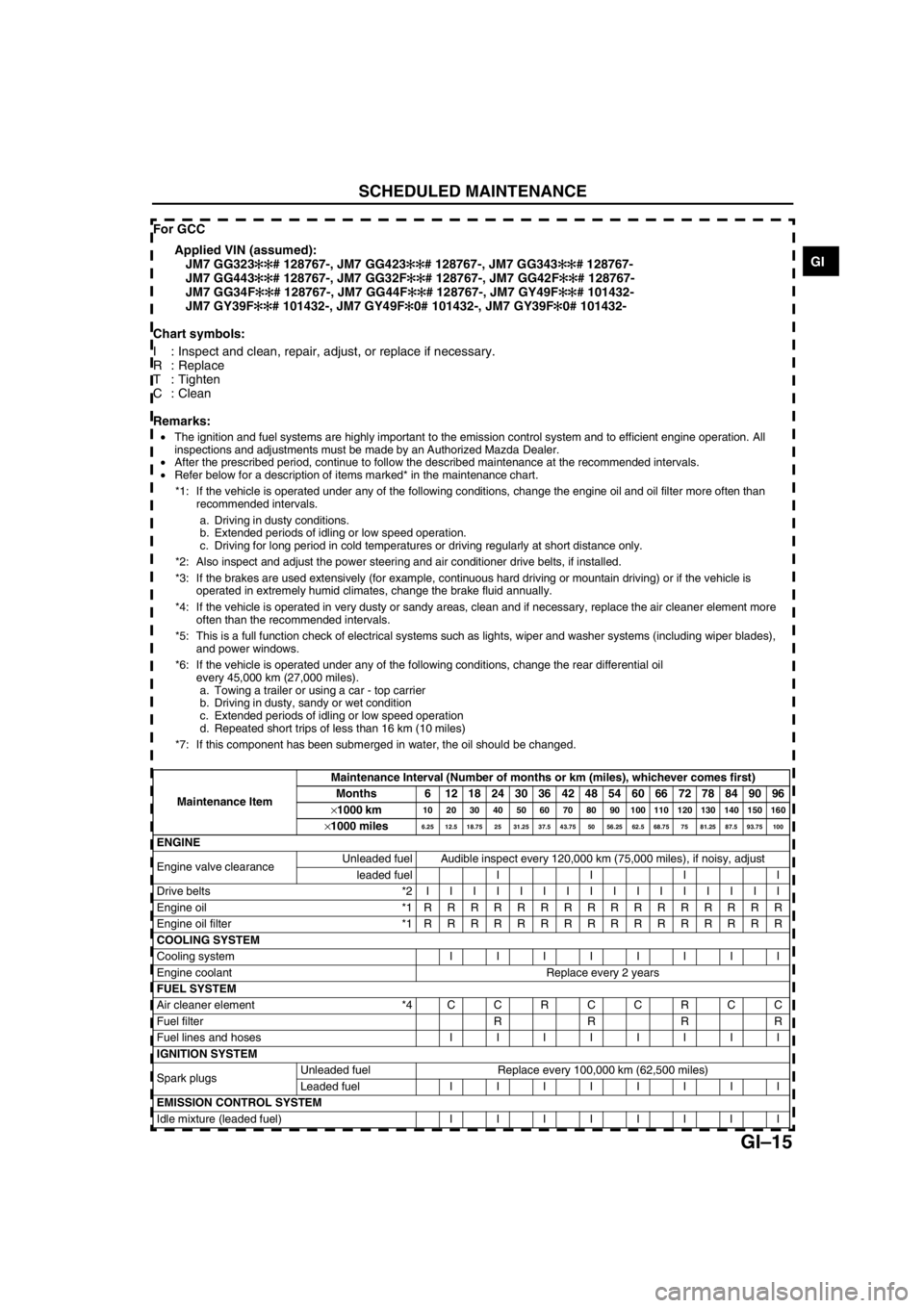
SCHEDULED MAINTENANCE
GI–15
GI
For GCC
Applied VIN (assumed):
JM7 GG323✻✻
✻✻✻✻ ✻✻
# 128767-, JM7 GG423✻✻
✻✻✻✻ ✻✻
# 128767-, JM7 GG343✻✻
✻✻✻✻ ✻✻
# 128767-
JM7 GG443✻✻
✻✻✻✻ ✻✻
# 128767-, JM7 GG32F✻✻
✻✻✻✻ ✻✻
# 128767-, JM7 GG42F✻✻
✻✻✻✻ ✻✻
# 128767-
JM7 GG34F✻
✻✻ ✻✻
✻✻ ✻
# 128767-, JM7 GG44F✻
✻✻ ✻✻
✻✻ ✻
# 128767-, JM7 GY49F✻✻
✻✻✻✻ ✻✻
# 101432-
JM7 GY39F✻✻
✻✻✻✻ ✻✻
# 101432-, JM7 GY49F✻
✻✻ ✻
0# 101432-, JM7 GY39F✻
✻✻ ✻
0# 101432-
Chart symbols:
I : Inspect and clean, repair, adjust, or replace if necessary.
R : Replace
T:Tighten
C : Clean
Remarks:
•The ignition and fuel systems are highly important to the emission control system and to efficient engine operation. All
inspections and adjustments must be made by an Authorized Mazda Dealer.
•After the prescribed period, continue to follow the described maintenance at the recommended intervals.
•Refer below for a description of items marked* in the maintenance chart.
*1: If the vehicle is operated under any of the following conditions, change the engine oil and oil filter more often than
recommended intervals.
a. Driving in dusty conditions.
b. Extended periods of idling or low speed operation.
c. Driving for long period in cold temperatures or driving regularly at short distance only.
*2: Also inspect and adjust the power steering and air conditioner drive belts, if installed.
*3: If the brakes are used extensively (for example, continuous hard driving or mountain driving) or if the vehicle is
operated in extremely humid climates, change the brake fluid annually.
*4: If the vehicle is operated in very dusty or sandy areas, clean and if necessary, replace the air cleaner element more
often than the recommended intervals.
*5: This is a full function check of electrical systems such as lights, wiper and washer systems (including wiper blades),
and power windows.
*6: If the vehicle is operated under any of the following conditions, change the rear differential oil
every 45,000 km (27,000 miles).
a. Towing a trailer or using a car - top carrier
b. Driving in dusty, sandy or wet condition
c. Extended periods of idling or low speed operation
d. Repeated short trips of less than 16 km (10 miles)
*7: If this component has been submerged in water, the oil should be changed.
Maintenance ItemMaintenance Interval (Number of months or km (miles), whichever comes first)
Months 6 121824303642485460667278849096
×1000 km
10 20 30 40 50 60 70 80 90 100 110 120 130 140 150 160
×1000 miles6.25 12.5 18.75 25 31.25 37.5 43.75 50 56.25 62.5 68.75 75 81.25 87.5 93.75 100
ENGINE
Engine valve clearance Unleaded fuel Audible inspect every 120,000 km (75,000 miles), if noisy, adjust
leaded fuel I I I I
Drive belts *2IIIIIIIIIIIIIIII
Engine oil *1RRRRRRRRRRRRRRRR
Engine oil filter *1RRRRRRRRRRRRRRRR
COOLING SYSTEM
Cooling system IIIIIIII
Engine coolant Replace every 2 years
FUEL SYSTEM
Air cleaner element *4CCRCCRCC
Fuel filter R R R R
Fuel lines and hoses IIIIIIII
IGNITION SYSTEM
Spark plugs Unleaded fuel Replace every 100,000 km (62,500 miles)
Leaded fuel IIIIIIII
EMISSION CONTROL SYSTEM
Idle mixture (leaded fuel) IIIIIIII
Page 21 of 909

SCHEDULED MAINTENANCE
GI–17
GI
Scheduled Maintenance Service (Specific Work Required)
•The specific work required for each maintenance item is listed in the following table. (Please refer to the section
applicable to the model serviced.)
For Europe (L.H.D. U.K.)
Bold frames: New item
Maintenance Item Specific Work Required
ENGINE
Engine valve clearance Measure clearance
Drive beltsInspect for wear, cracks and fraying, and check tension.
Replace drive belt.
Engine timing belt Replace engine timing belt.
Engine oil Replace engine oil and inspect for leakage.
Oil filter Replace oil filter and inspect for leakage.
COOLING SYSTEM
Cooling system
(including coolant level adjustment)Check coolant level and quality, and inspect for leakage.
Engine coolant Replace coolant.
FUEL SYSTEM
Air cleaner elementInspect for dirt, oil and damage.
Clean air cleaner element (by blowing air).
Replace air cleaner element.
Fuel filter Replace fuel filter.
Fuel lines and hoses Inspect for cracks, leakage and loose connection.
Fuel injection system (for MZR-CD (RF Turbo)) Update to injection amount correction with WDS. (see W/M)
IGNITION SYSTEM (FOR GASOLINE)
Spark plugsInspect for wear, damage, carbon, high-tension lead condition and measure
plug gap.
Replace spark plugs.
EMISSION CONTROL SYSTEM
Evaporative system (for gasoline)Check system operation (see W/M), vapor lines, vacuum fitting hoses and
connection.
E.G.R. system (MZR-CR (RF Turbo))Check system operation (see W/M), vacuum fitting hoses and connection.
Update to MAF correction for E.G.R control with WDS. (see W/M)
ELECTRICAL SYSTEM
Battery electrolyte level and specific gravity Check level and specific gravity.
CHASSIS AND BODY
Brake fluidCheck fluid level and inspect for leakage.
Replace brake fluid.
Brake lines, hoses and connectionsInspect for cracks, damage, chafing, corrosion, scars, swelling and fluid
leakage.
Parking brake Check lever stroke.
Power brake unit and hosesCheck vacuum lines, connections and check valve for improper attachment,
air tightness, cracks chafing and deterioration.
Disc brakesTest for judder and noise. Inspect caliper for correct operation and fluid
leakage, brake pads for wear. Check disc plate condition and thickness.
Power steering fluid and linesCheck fluid level and lines for improper attachment, leakage, cracks,
damage, loose connections, chafing and deterioration.
Power steering fluid Check fluid level.
Power steering system and hosesCheck lines for improper attachment, leakage, cracks, damage, loose
connections, chafing and deterioration.
Steering operation and gear housingCheck that the steering wheel has the specified play. Be sure to check for
changes, such as excessive play, hard steering or strange noises.
Check gear housing and boots for looseness, damage and grease/gear oil
leakage.
Steering linkages tie rod ends and armsCheck ball joint, dust cover and other components for looseness, wear,
damage and grease leakage.
Front and rear suspension and ball joints Inspect for grease leakage, cracks, damage and looseness.
Manual transmission/transaxle oilCheck oil level and inspect for leakage.
Replace manual transmission/transaxle oil.
Automatic transmission/transaxle fluid level Check fluid level.
Page 26 of 909
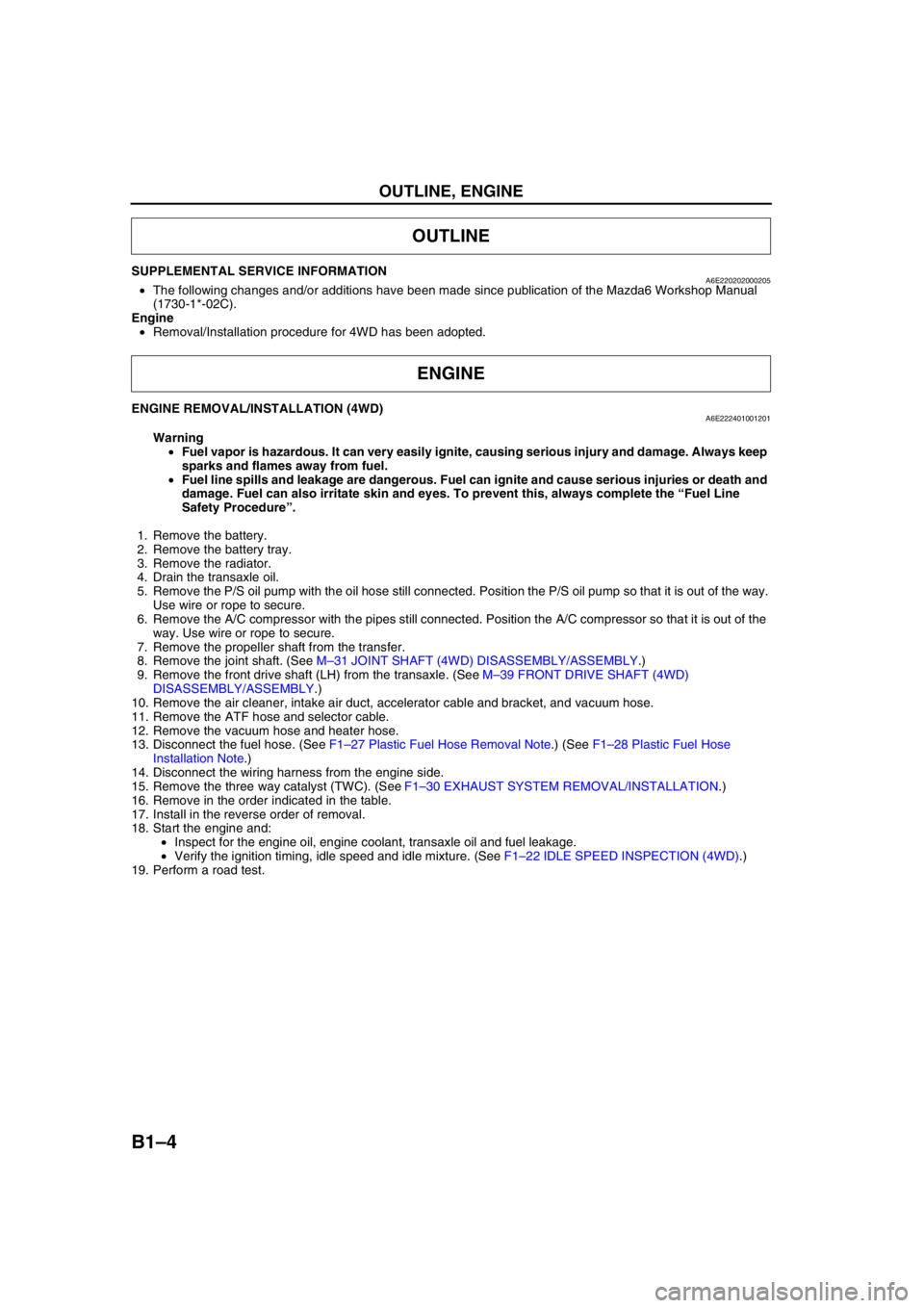
B1–4
OUTLINE, ENGINE
SUPPLEMENTAL SERVICE INFORMATIONA6E220202000205•The following changes and/or additions have been made since publication of the Mazda6 Workshop Manual
(1730-1*-02C).
Engine
•Removal/Installation procedure for 4WD has been adopted.
End Of Sie
ENGINE REMOVAL/INSTALLATION (4WD)A6E222401001201
Warning
•Fuel vapor is hazardous. It can very easily ignite, causing serious injury and damage. Always keep
sparks and flames away from fuel.
•Fuel line spills and leakage are dangerous. Fuel can ignite and cause serious injuries or death and
damage. Fuel can also irritate skin and eyes. To prevent this, always complete the “Fuel Line
Safety Procedure”.
1. Remove the battery.
2. Remove the battery tray.
3. Remove the radiator.
4. Drain the transaxle oil.
5. Remove the P/S oil pump with the oil hose still connected. Position the P/S oil pump so that it is out of the way.
Use wire or rope to secure.
6. Remove the A/C compressor with the pipes still connected. Position the A/C compressor so that it is out of the
way. Use wire or rope to secure.
7. Remove the propeller shaft from the transfer.
8. Remove the joint shaft. (See M–31 JOINT SHAFT (4WD) DISASSEMBLY/ASSEMBLY.)
9. Remove the front drive shaft (LH) from the transaxle. (See M–39 FRONT DRIVE SHAFT (4WD)
DISASSEMBLY/ASSEMBLY.)
10. Remove the air cleaner, intake air duct, accelerator cable and bracket, and vacuum hose.
11. Remove the ATF hose and selector cable.
12. Remove the vacuum hose and heater hose.
13. Disconnect the fuel hose. (See F1–27 Plastic Fuel Hose Removal Note.) (See F1–28 Plastic Fuel Hose
Installation Note.)
14. Disconnect the wiring harness from the engine side.
15. Remove the three way catalyst (TWC). (See F1–30 EXHAUST SYSTEM REMOVAL/INSTALLATION.)
16. Remove in the order indicated in the table.
17. Install in the reverse order of removal.
18. Start the engine and:
•Inspect for the engine oil, engine coolant, transaxle oil and fuel leakage.
•Verify the ignition timing, idle speed and idle mixture. (See F1–22 IDLE SPEED INSPECTION (4WD).)
19. Perform a road test.
OUTLINE
ENGINE
Page 37 of 909
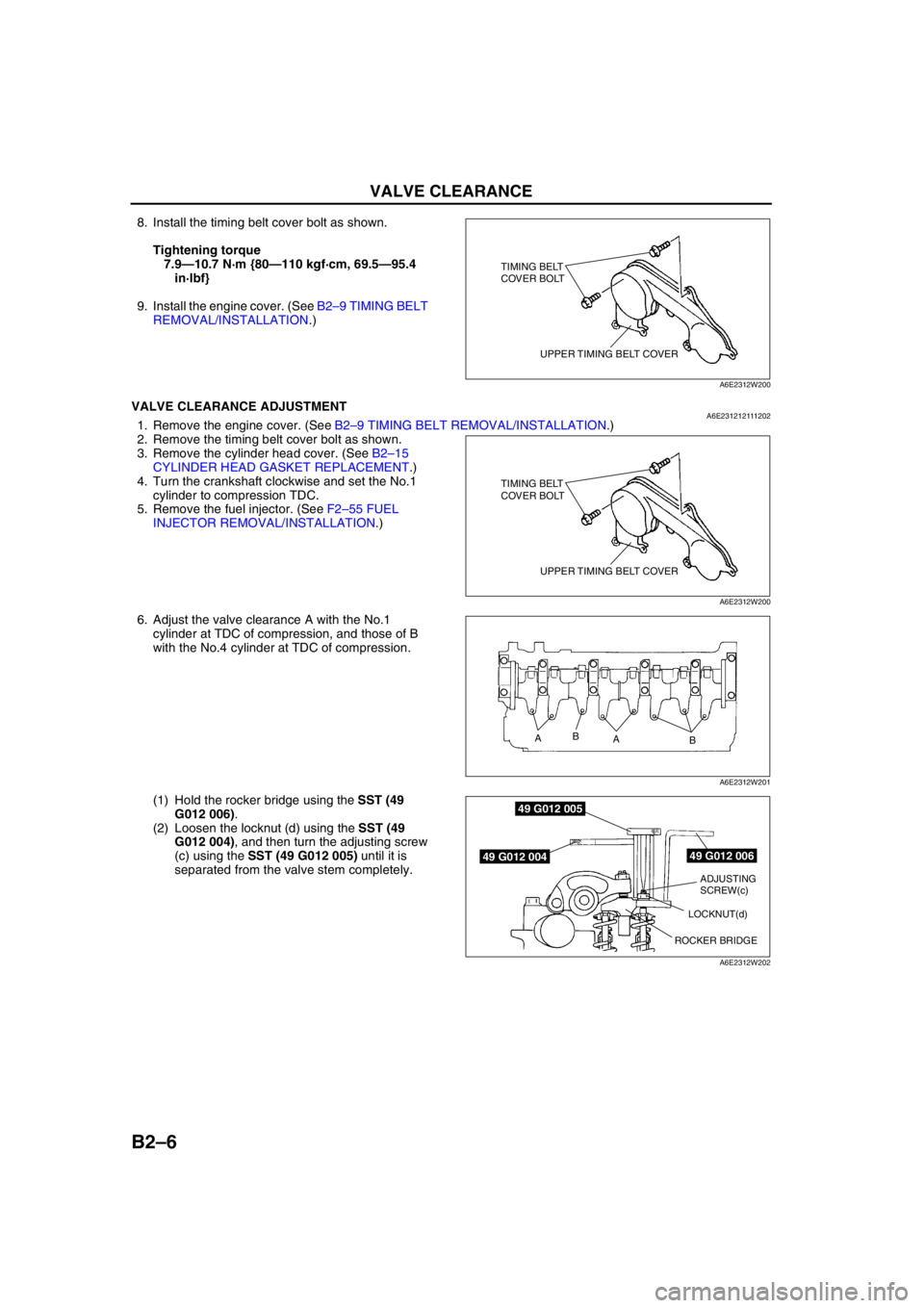
B2–6
VALVE CLEARANCE
8. Install the timing belt cover bolt as shown.
Tightening torque
7.9—10.7 N·m {80—110 kgf·cm, 69.5—95.4
in·lbf}
9. Install the engine cover. (See B2–9 TIMING BELT
REMOVAL/INSTALLATION.)
End Of SieVALVE CLEARANCE ADJUSTMENTA6E2312121112021. Remove the engine cover. (See B2–9 TIMING BELT REMOVAL/INSTALLATION.)
2. Remove the timing belt cover bolt as shown.
3. Remove the cylinder head cover. (See B2–15
CYLINDER HEAD GASKET REPLACEMENT.)
4. Turn the crankshaft clockwise and set the No.1
cylinder to compression TDC.
5. Remove the fuel injector. (See F2–55 FUEL
INJECTOR REMOVAL/INSTALLATION.)
6. Adjust the valve clearance A with the No.1
cylinder at TDC of compression, and those of B
with the No.4 cylinder at TDC of compression.
(1) Hold the rocker bridge using the SST (49
G012 006).
(2) Loosen the locknut (d) using the SST (49
G012 004), and then turn the adjusting screw
(c) using the SST (49 G012 005) until it is
separated from the valve stem completely.
TIMING BELT
COVER BOLT
UPPER TIMING BELT COVER
A6E2312W200
TIMING BELT
COVER BOLT
UPPER TIMING BELT COVER
A6E2312W200
A
A B
B
A6E2312W201
49 G012 006
49 G012 005
49 G012 004
ADJUSTING
SCREW(c)
ROCKER BRIDGELOCKNUT(d)
NORMAL
A6E2312W202
Page 38 of 909
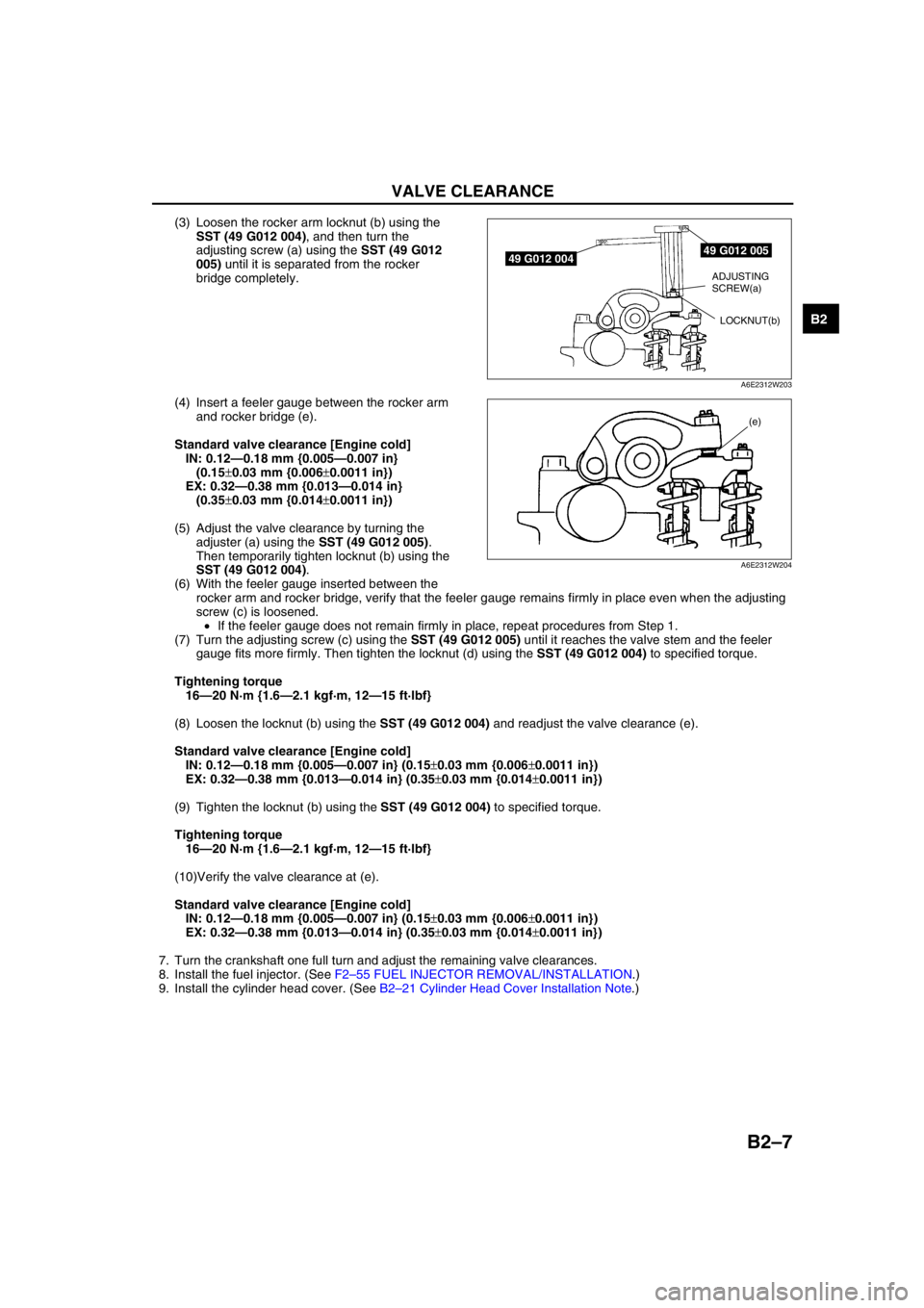
VALVE CLEARANCE
B2–7
B2
(3) Loosen the rocker arm locknut (b) using the
SST (49 G012 004), and then turn the
adjusting screw (a) using the SST (49 G012
005) until it is separated from the rocker
bridge completely.
(4) Insert a feeler gauge between the rocker arm
and rocker bridge (e).
Standard valve clearance [Engine cold]
IN: 0.12—0.18 mm {0.005—0.007 in}
(0.15±0.03 mm {0.006±0.0011 in})
EX: 0.32—0.38 mm {0.013—0.014 in}
(0.35±0.03 mm {0.014±0.0011 in})
(5) Adjust the valve clearance by turning the
adjuster (a) using the SST (49 G012 005).
Then temporarily tighten locknut (b) using the
SST (49 G012 004).
(6) With the feeler gauge inserted between the
rocker arm and rocker bridge, verify that the feeler gauge remains firmly in place even when the adjusting
screw (c) is loosened.
•If the feeler gauge does not remain firmly in place, repeat procedures from Step 1.
(7) Turn the adjusting screw (c) using the SST (49 G012 005) until it reaches the valve stem and the feeler
gauge fits more firmly. Then tighten the locknut (d) using the SST (49 G012 004) to specified torque.
Tightening torque
16—20 N·m {1.6—2.1 kgf·m, 12—15 ft·lbf}
(8) Loosen the locknut (b) using the SST (49 G012 004) and readjust the valve clearance (e).
Standard valve clearance [Engine cold]
IN: 0.12—0.18 mm {0.005—0.007 in} (0.15±0.03 mm {0.006±0.0011 in})
EX: 0.32—0.38 mm {0.013—0.014 in} (0.35±0.03 mm {0.014±0.0011 in})
(9) Tighten the locknut (b) using the SST (49 G012 004) to specified torque.
Tightening torque
16—20 N·m {1.6—2.1 kgf·m, 12—15 ft·lbf}
(10)Verify the valve clearance at (e).
Standard valve clearance [Engine cold]
IN: 0.12—0.18 mm {0.005—0.007 in} (0.15±0.03 mm {0.006±0.0011 in})
EX: 0.32—0.38 mm {0.013—0.014 in} (0.35±0.03 mm {0.014±0.0011 in})
7. Turn the crankshaft one full turn and adjust the remaining valve clearances.
8. Install the fuel injector. (See F2–55 FUEL INJECTOR REMOVAL/INSTALLATION.)
9. Install the cylinder head cover. (See B2–21 Cylinder Head Cover Installation Note.)
49 G012 00549 G012 004
LOCKNUT(b) ADJUSTING
SCREW(a)
A6E2312W203
(e)
A6E2312W204
Page 39 of 909
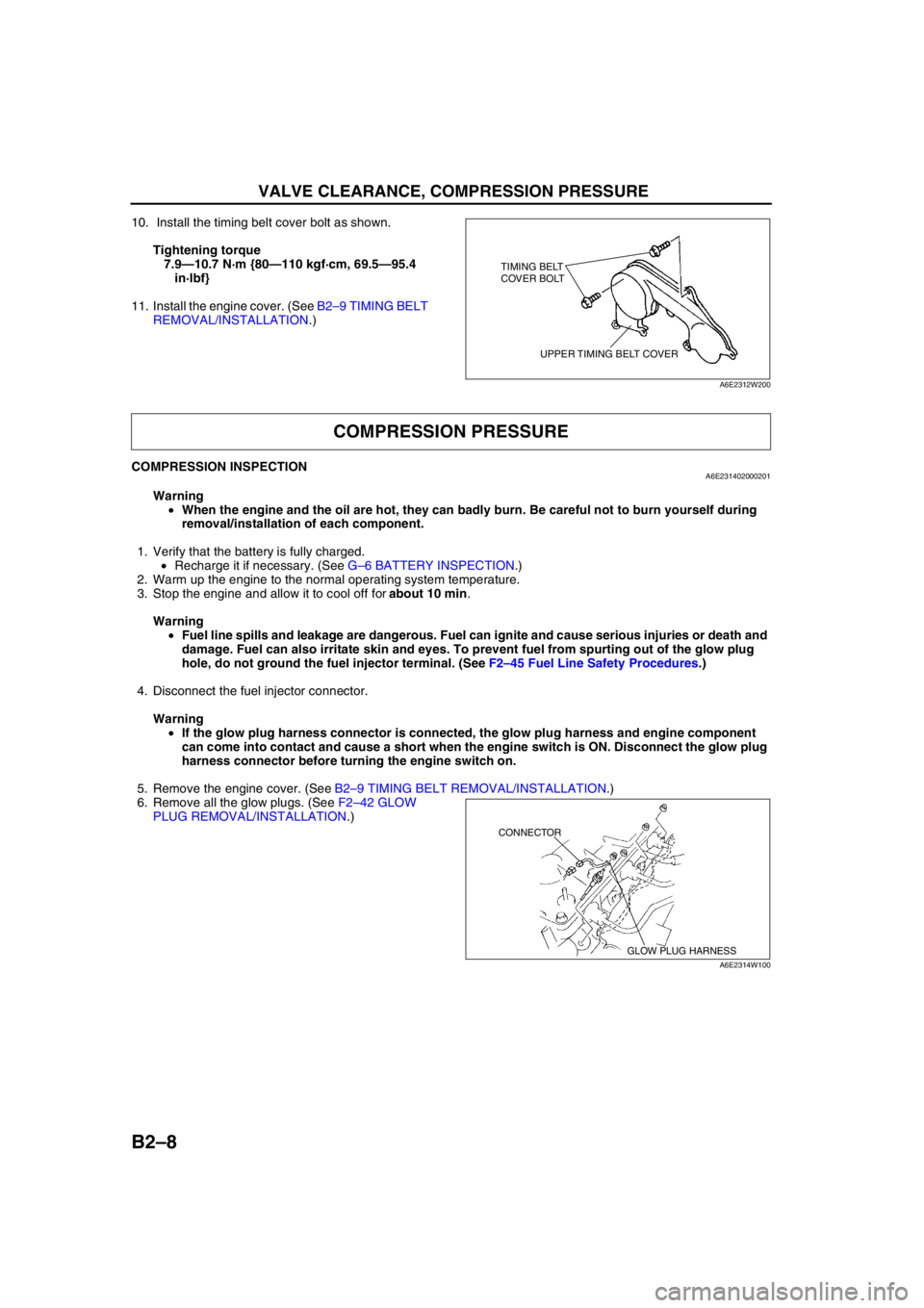
B2–8
VALVE CLEARANCE, COMPRESSION PRESSURE
10. Install the timing belt cover bolt as shown.
Tightening torque
7.9—10.7 N·m {80—110 kgf·cm, 69.5—95.4
in·lbf}
11. Install the engine cover. (See B2–9 TIMING BELT
REMOVAL/INSTALLATION.)
End Of Sie
COMPRESSION INSPECTIONA6E231402000201
Warning
•When the engine and the oil are hot, they can badly burn. Be careful not to burn yourself during
removal/installation of each component.
1. Verify that the battery is fully charged.
•Recharge it if necessary. (See G–6 BATTERY INSPECTION.)
2. Warm up the engine to the normal operating system temperature.
3. Stop the engine and allow it to cool off for about 10 min.
Warning
•Fuel line spills and leakage are dangerous. Fuel can ignite and cause serious injuries or death and
damage. Fuel can also irritate skin and eyes. To prevent fuel from spurting out of the glow plug
hole, do not ground the fuel injector terminal. (See F2–45 Fuel Line Safety Procedures.)
4. Disconnect the fuel injector connector.
Warning
•If the glow plug harness connector is connected, the glow plug harness and engine component
can come into contact and cause a short when the engine switch is ON. Disconnect the glow plug
harness connector before turning the engine switch on.
5. Remove the engine cover. (See B2–9 TIMING BELT REMOVAL/INSTALLATION.)
6. Remove all the glow plugs. (See F2–42 GLOW
PLUG REMOVAL/INSTALLATION.)
TIMING BELT
COVER BOLT
UPPER TIMING BELT COVER
A6E2312W200
COMPRESSION PRESSURE
GLOW PLUG HARNESS CONNECTOR
A6E2314W100
Page 40 of 909
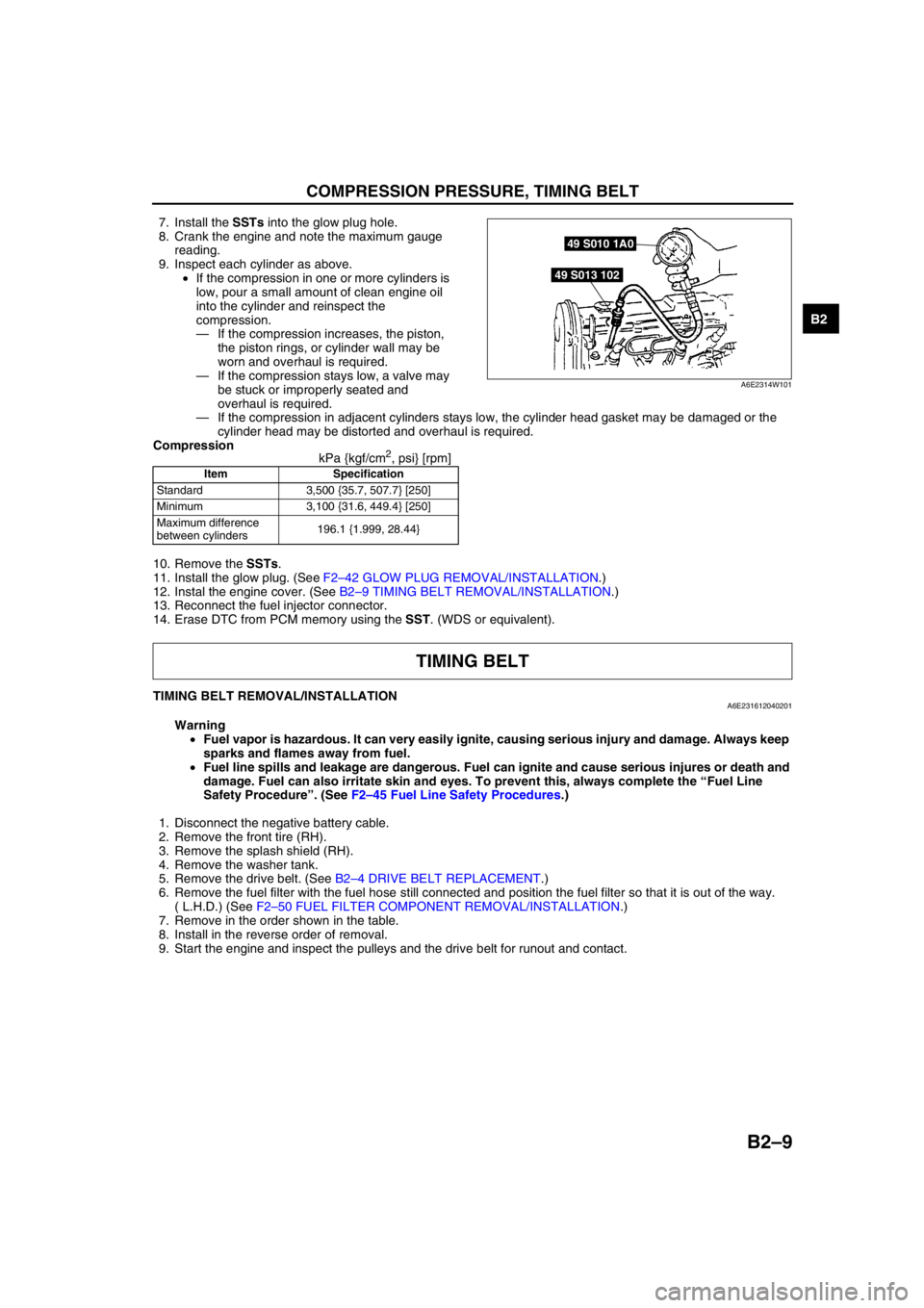
COMPRESSION PRESSURE, TIMING BELT
B2–9
B2
7. Install the SSTs into the glow plug hole.
8. Crank the engine and note the maximum gauge
reading.
9. Inspect each cylinder as above.
•If the compression in one or more cylinders is
low, pour a small amount of clean engine oil
into the cylinder and reinspect the
compression.
—If the compression increases, the piston,
the piston rings, or cylinder wall may be
worn and overhaul is required.
—If the compression stays low, a valve may
be stuck or improperly seated and
overhaul is required.
—If the compression in adjacent cylinders stays low, the cylinder head gasket may be damaged or the
cylinder head may be distorted and overhaul is required.
Compression
kPa {kgf/cm
2, psi} [rpm]
10. Remove the SSTs.
11. Install the glow plug. (See F2–42 GLOW PLUG REMOVAL/INSTALLATION.)
12. Instal the engine cover. (See B2–9 TIMING BELT REMOVAL/INSTALLATION.)
13. Reconnect the fuel injector connector.
14. Erase DTC from PCM memory using the SST. (WDS or equivalent).
End Of Sie
TIMING BELT REMOVAL/INSTALLATIONA6E231612040201
Warning
•Fuel vapor is hazardous. It can very easily ignite, causing serious injury and damage. Always keep
sparks and flames away from fuel.
•Fuel line spills and leakage are dangerous. Fuel can ignite and cause serious injures or death and
damage. Fuel can also irritate skin and eyes. To prevent this, always complete the “Fuel Line
Safety Procedure”. (See F2–45 Fuel Line Safety Procedures.)
1. Disconnect the negative battery cable.
2. Remove the front tire (RH).
3. Remove the splash shield (RH).
4. Remove the washer tank.
5. Remove the drive belt. (See B2–4 DRIVE BELT REPLACEMENT.)
6. Remove the fuel filter with the fuel hose still connected and position the fuel filter so that it is out of the way.
( L.H.D.) (See F2–50 FUEL FILTER COMPONENT REMOVAL/INSTALLATION.)
7. Remove in the order shown in the table.
8. Install in the reverse order of removal.
9. Start the engine and inspect the pulleys and the drive belt for runout and contact.
Item Specification
Standard 3,500 {35.7, 507.7} [250]
Minimum 3,100 {31.6, 449.4} [250]
Maximum difference
between cylinders196.1 {1.999, 28.44}
49 S010 1A0
49 S013 102
A6E2314W101
TIMING BELT
Page 44 of 909
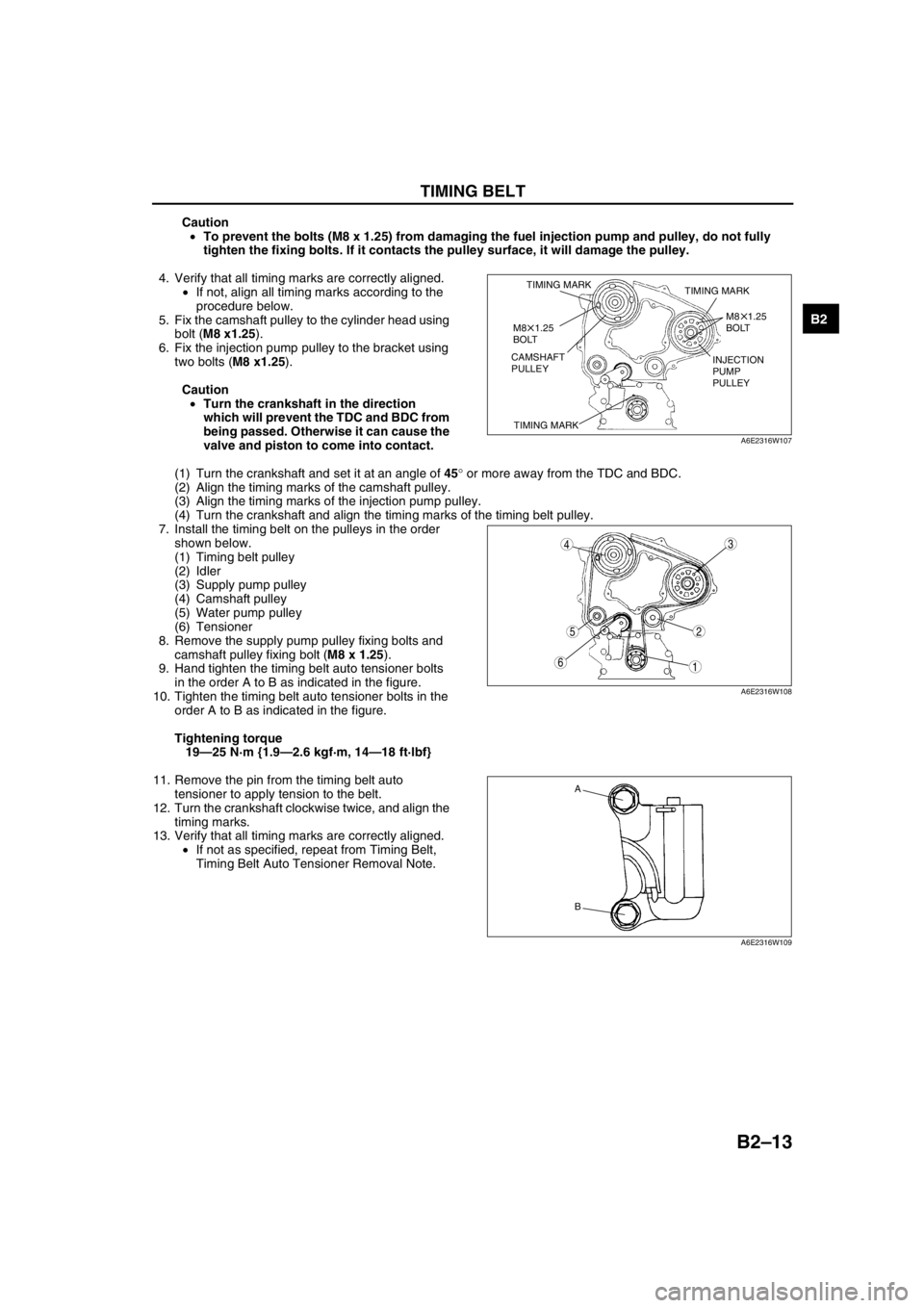
TIMING BELT
B2–13
B2
Caution
•To prevent the bolts (M8 x 1.25) from damaging the fuel injection pump and pulley, do not fully
tighten the fixing bolts. If it contacts the pulley surface, it will damage the pulley.
4. Verify that all timing marks are correctly aligned.
•If not, align all timing marks according to the
procedure below.
5. Fix the camshaft pulley to the cylinder head using
bolt (M8 x1.25).
6. Fix the injection pump pulley to the bracket using
two bolts (M8 x1.25).
Caution
•Turn the crankshaft in the direction
which will prevent the TDC and BDC from
being passed. Otherwise it can cause the
valve and piston to come into contact.
(1) Turn the crankshaft and set it at an angle of 45° or more away from the TDC and BDC.
(2) Align the timing marks of the camshaft pulley.
(3) Align the timing marks of the injection pump pulley.
(4) Turn the crankshaft and align the timing marks of the timing belt pulley.
7. Install the timing belt on the pulleys in the order
shown below.
(1) Timing belt pulley
(2) Idler
(3) Supply pump pulley
(4) Camshaft pulley
(5) Water pump pulley
(6) Tensioner
8. Remove the supply pump pulley fixing bolts and
camshaft pulley fixing bolt (M8 x 1.25).
9. Hand tighten the timing belt auto tensioner bolts
in the order A to B as indicated in the figure.
10. Tighten the timing belt auto tensioner bolts in the
order A to B as indicated in the figure.
Tightening torque
19—25 N·m {1.9—2.6 kgf·m, 14—18 ft·lbf}
11. Remove the pin from the timing belt auto
tensioner to apply tension to the belt.
12. Turn the crankshaft clockwise twice, and align the
timing marks.
13. Verify that all timing marks are correctly aligned.
•If not as specified, repeat from Timing Belt,
Timing Belt Auto Tensioner Removal Note.
TIMING MARK
TIMING MARKTIMING MARK
M8 1.25
BOLT
M8 1.25
BOLT
CAMSHAFT
PULLEYINJECTION
PUMP
PULLEY
A6E2316W107
5
43
1
2
6
A6E2316W108
A
B
A6E2316W109
Page 46 of 909
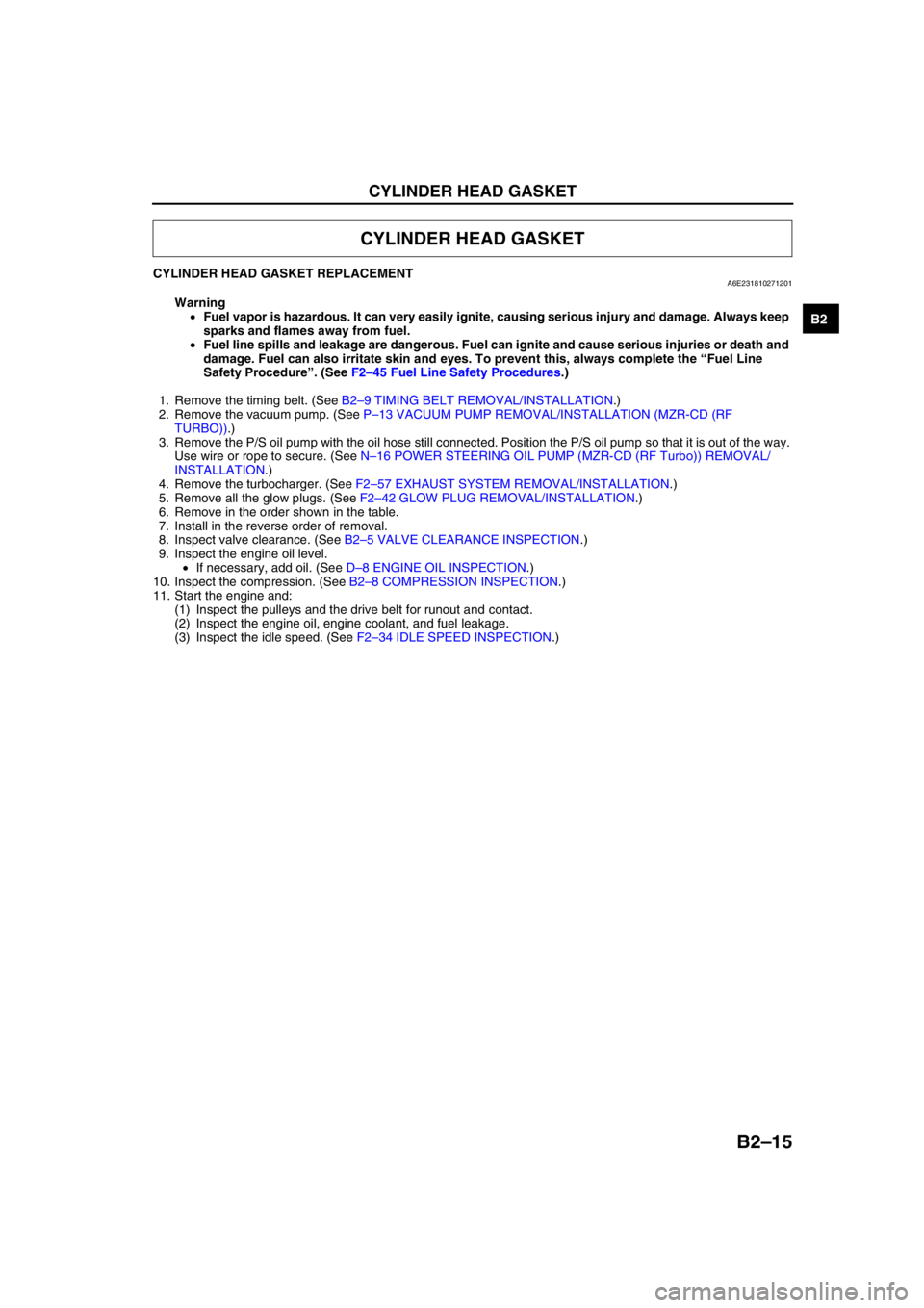
CYLINDER HEAD GASKET
B2–15
B2
End Of Sie
CYLINDER HEAD GASKET REPLACEMENTA6E231810271201
Warning
•Fuel vapor is hazardous. It can very easily ignite, causing serious injury and damage. Always keep
sparks and flames away from fuel.
•Fuel line spills and leakage are dangerous. Fuel can ignite and cause serious injuries or death and
damage. Fuel can also irritate skin and eyes. To prevent this, always complete the “Fuel Line
Safety Procedure”. (See F2–45 Fuel Line Safety Procedures.)
1. Remove the timing belt. (See B2–9 TIMING BELT REMOVAL/INSTALLATION.)
2. Remove the vacuum pump. (See P–13 VACUUM PUMP REMOVAL/INSTALLATION (MZR-CD (RF
TURBO)).)
3. Remove the P/S oil pump with the oil hose still connected. Position the P/S oil pump so that it is out of the way.
Use wire or rope to secure. (See N–16 POWER STEERING OIL PUMP (MZR-CD (RF Turbo)) REMOVAL/
INSTALLATION.)
4. Remove the turbocharger. (See F2–57 EXHAUST SYSTEM REMOVAL/INSTALLATION.)
5. Remove all the glow plugs. (See F2–42 GLOW PLUG REMOVAL/INSTALLATION.)
6. Remove in the order shown in the table.
7. Install in the reverse order of removal.
8. Inspect valve clearance. (See B2–5 VALVE CLEARANCE INSPECTION.)
9. Inspect the engine oil level.
•If necessary, add oil. (See D–8 ENGINE OIL INSPECTION.)
10. Inspect the compression. (See B2–8 COMPRESSION INSPECTION.)
11. Start the engine and:
(1) Inspect the pulleys and the drive belt for runout and contact.
(2) Inspect the engine oil, engine coolant, and fuel leakage.
(3) Inspect the idle speed. (See F2–34 IDLE SPEED INSPECTION.)
CYLINDER HEAD GASKET
Page 47 of 909
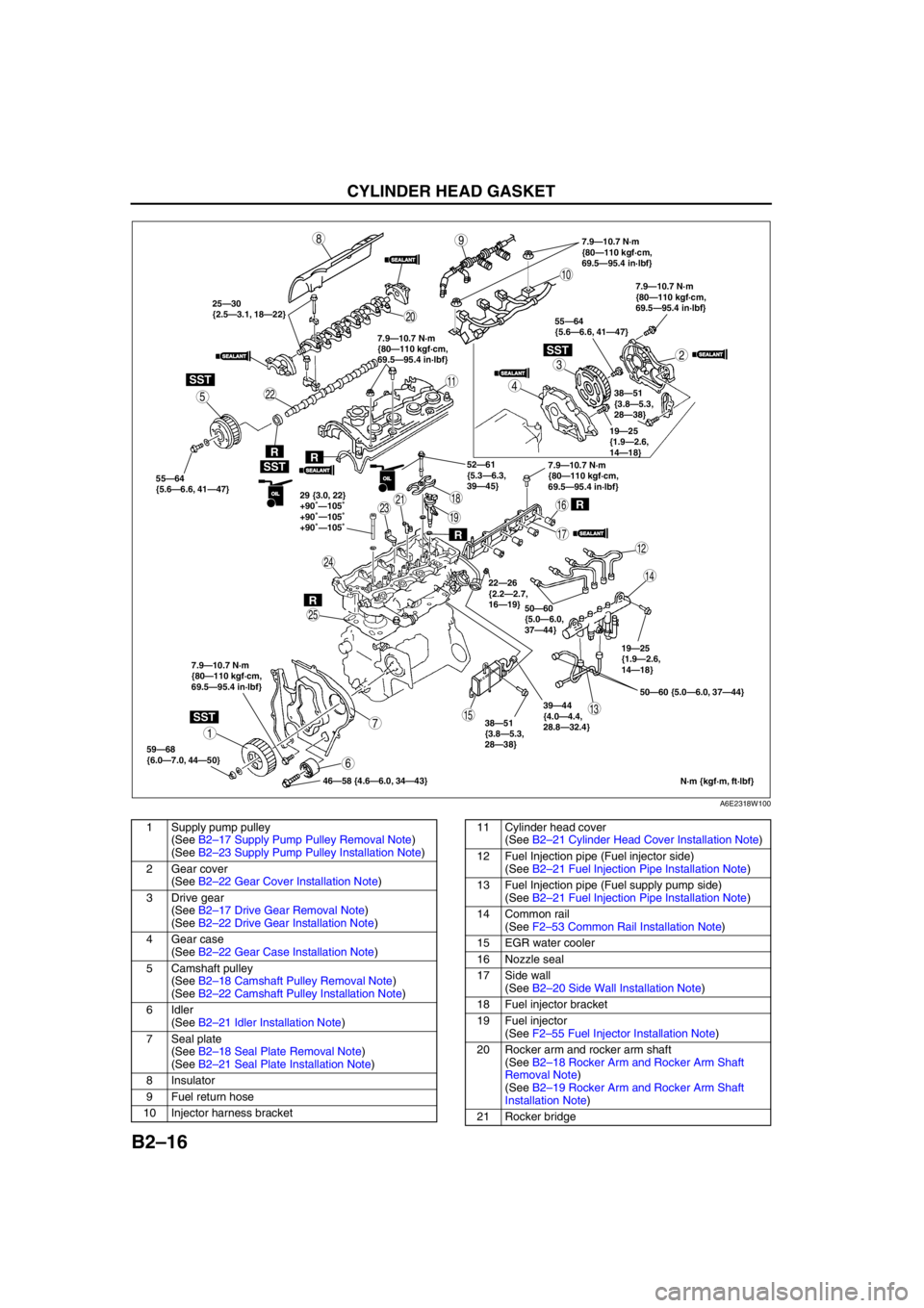
B2–16
CYLINDER HEAD GASKET
.
SST
SST
SSTR
R
R
R
R
SEALANTSEALANT
SEALANTSEALANT
SEALANTSEALANT
SEALANTSEALANT
SEALANTSEALANT
OILOIL
OILOIL
7.9—10.7 N·m
{80—110 kgf·cm,
69.5—95.4 in·lbf}
7.9—10.7 N·m
{80—110 kgf·cm,
69.5—95.4 in·lbf}
7.9—10.7 N·m
{80—110 kgf·cm,
69.5—95.4 in·lbf} 7.9—10.7 N·m
{80—110 kgf·cm,
69.5—95.4 in·lbf}
7.9—10.7 N·m
{80—110 kgf·cm,
69.5—95.4 in·lbf}55—64
{5.6—6.6, 41—47}
38—51
{3.8—5.3,
28—38}
52—61
{5.3—6.3,
39—45}
29 {3.0, 22}
+90 105
+90 105
+90 105
50—60
{5.0—6.0,
37—44}
19—25
{1.9—2.6,
14—18}
50—60 {5.0—6.0, 37—44}
46—58 {4.6—6.0, 34—43} 59—68
{6.0—7.0, 44—50}25—30
{2.5—3.1, 18—22}
38—51
{3.8—5.3,
28—38}19—25
{1.9—2.6,
14—18}
N·m {kgf·m, ft·lbf}
98
7
54
3
1
2
10
19
18
17
15
16
14
13
11
12
20
25
24
2321
22
6
SST
55—64
{5.6—6.6, 41—47}
—
— —
39—44
{4.0—4.4,
28.8—32.4}
22—26
{2.2—2.7,
16—19}
SEALANTSEALANT
A6E2318W100
1 Supply pump pulley
(See B2–17 Supply Pump Pulley Removal Note)
(See B2–23 Supply Pump Pulley Installation Note)
2 Gear cover
(See B2–22 Gear Cover Installation Note)
3 Drive gear
(See B2–17 Drive Gear Removal Note)
(See B2–22 Drive Gear Installation Note)
4 Gear case
(See B2–22 Gear Case Installation Note)
5 Camshaft pulley
(See B2–18 Camshaft Pulley Removal Note)
(See B2–22 Camshaft Pulley Installation Note)
6 Idler
(See B2–21 Idler Installation Note)
7 Seal plate
(See B2–18 Seal Plate Removal Note)
(See B2–21 Seal Plate Installation Note)
8 Insulator
9 Fuel return hose
10 Injector harness bracket11 Cylinder head cover
(See B2–21 Cylinder Head Cover Installation Note)
12 Fuel Injection pipe (Fuel injector side)
(See B2–21 Fuel Injection Pipe Installation Note)
13 Fuel Injection pipe (Fuel supply pump side)
(See B2–21 Fuel Injection Pipe Installation Note)
14 Common rail
(See F2–53 Common Rail Installation Note)
15 EGR water cooler
16 Nozzle seal
17 Side wall
(See B2–20 Side Wall Installation Note)
18 Fuel injector bracket
19 Fuel injector
(See F2–55 Fuel Injector Installation Note)
20 Rocker arm and rocker arm shaft
(See B2–18 Rocker Arm and Rocker Arm Shaft
Removal Note)
(See B2–19 Rocker Arm and Rocker Arm Shaft
Installation Note)
21 Rocker bridge